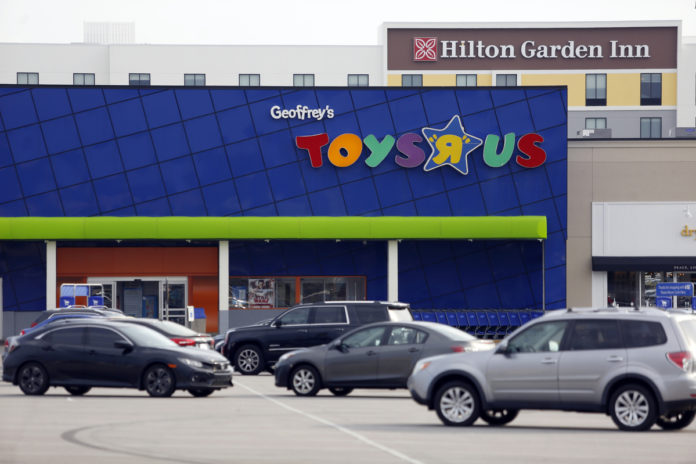
NEW YORK – Toys “R” Us Inc., the once-dominant specialty retailer and ultimate toyland for a generation of post-war baby boomers, filed for bankruptcy thanks to a crushing debt load from a previous buyout and relentless competition from warehouse and online retailers.
The bankruptcy filing is the latest blow to a brick-and-mortar retail industry reeling from store closures, sluggish mall traffic and the gravitational pull of Amazon.com Inc., which has revolutionized the way people consume with affordable online offerings and global home delivery service.
A dozen-plus major retailers have filed for creditor protection this year, including Payless Inc., Gymboree Corp. and Perfumania Holdings Inc., all of which are using the Chapter 11 process to close underperforming stores and expand online operations.
The shakeout is also reverberating across American malls and shopping districts. More than 10 percent of U.S. retail space, or nearly 1 billion square feet, may need to be closed, converted to other uses or renegotiated for lower rent in coming years, according to data provided to Bloomberg by CoStar Group.
The troubles at Toys “R” Us come as retailers and suppliers ramp up for the all-important holiday shopping season. In an emailed statement, Mattel Inc. said, “As one of our most important retail partners, we are committed to supporting Toys ‘R’ Us and its management team as they work through this process, particularly as we approach the holiday season.”
The bankruptcy filing by the company also may have global implications, especially for Chinese toy manufacturers. Some 38 percent of the company’s revenue came from overseas markets in the latest fiscal year. “It’s a loss for the long-term benefit of the entire industry,” said Lun Leung, chairman of Hong Kong-based Lung Cheong Group, a toy supplier for Hasbro Inc. He said Toys “R” Us accounted for less than 5 percent of the group’s sales.
Despite early volatility, Hasbro’s stock increased $1.51 on the day as of 1:45 p.m. Tuesday. Last quarter, Hasbro reported $849.7 million in revenue with nearly half of that revenue earned internationally. Hasbro’s net profit for the second quarter was $67.7 million.
Crushing Debt
The company listed debt and assets of more than $1 billion each in Chapter 11 documents submitted Monday at the U.S. Bankruptcy Court in Richmond, Virginia. Prior to filing, the chain secured more than $3 billion in financing from lenders including a JPMorgan Chase & Co.-led bank syndicate and certain existing lenders to fund operations while it restructures, according to a company statement. The funding is subject to court approval.
The company didn’t announce plans to close stores, and said its locations across the globe would continue normal operations.
“Like any retailer, decisions about any future store closings – and openings – will continue to be made based on what makes the best sense for the business,” Michael Freitag, a spokesman for Toys “R” Us, said in an email.
Much of the toy merchant’s debt is the legacy of a $7.5 billion leveraged buyout in 2005 in which Bain Capital, KKR & Co. and Vornado Realty Trust loaded the company with debt to take it private. Since then, the Wayne, New Jersey-based chain has struggled to dig itself out.
Hot Toys
CEO David Brandon took over Toys “R” Us in 2015 and sought to make shopping there a more enjoyable experience. Last year, he set out a vision of kids “dragging their parents to our stores because they want to see what’s going on.”
The retailer introduced the “Hot Toy Finder,” which tells customers exactly where in their local store to find the items featured on its “ Holiday Hot Toy List.” The chain, which has provided the annual list of the 50 hottest toys for 20 years, also offered price matching and free layaway.
While Brandon made some progress reducing liabilities, he ultimately was unable to resuscitate the closely held chain’s fortunes. The company reported a net loss of $164 million in the quarter ended April 29, compared to $126 million for the same period in the prior year. It hasn’t shown an annual profit since 2013.
“Together with our investors, our objective is to work with our debtholders and other creditors to restructure the $5 billion of long-term debt on our balance sheet,” Brandon said in the company statement.
When reports surfaced recently that Toys “R” Us was weighing a bankruptcy filing, Chinese toy scooter maker Pinghu Mijia Child Product Co. put all of the retailer’s orders on hold, fearing it wouldn’t get paid, according to sales manager Justin Yu. The toy retailer represents about 10 to 20 percent of the Chinese supplier’s sales.
“We were shocked to hear the news last week because their orders to us have been rising every year, so we did not know they were in trouble,” Yu said. “They’re a major buyer and I would say that the majority of toy makers in China would have some contracts with them.”
Li Jiewei, a spokesman with the China Toy and Juvenile Products Association, thinks demand for toys remains robust, regardless of the problems at Toys “R” Us. “Total toy exports from China have been growing every year and growth remains strong so we don’t see it as an industry problem,” he said.
Bargain Town
Charles Lazarus opened Children’s Bargain Town, a baby-furniture store, in Washington in 1948, according to the Toys “R” Us website. He added toys two years later and opened the first Toys “R” Us, modeled after self-service supermarkets, in 1957. Lazarus stepped down as chairman and CEO in 1994. Two years later, the first Babies “R” Us opened.
The company sells toy and baby merchandise in about 1,600 Toys “R” Us and Babies “R” Us locations worldwide and through websites including Toysrus.com and Babiesrus.com.
The company’s Canadian unit intends to seek protection in parallel proceedings in the Ontario Superior Court of Justice, according to the statement. The company’s operations outside of the U.S. and Canada, including its about 255 licensed stores and joint-venture partnership with a retail unit of Hong Kong-based Fung Group, are not part of the Chapter 11 filing. In Australia, Toys “R” Us plans to add another five stores to its existing 39 there by Christmas, said Jessica Donovan, national marketing manager for the chain in the country.
Some loyal customers were disappointed by the bankruptcy news. “This is a great pity for all families with kids,” said Alex Ng, father of a three-year-old girl, at a Toys “R” Us outlet in Hong Kong. “Nowhere else can compare with its product variety and, most importantly, it provides a guarantee of product quality.”
The case is In re TRU-SVC, 17-34659, U.S. Bankruptcy Court, Eastern District of Virginia (Richmond).
Dawn McCarty and Daniela Wei are reporters for Bloomberg News. PBN contributed to this article.












